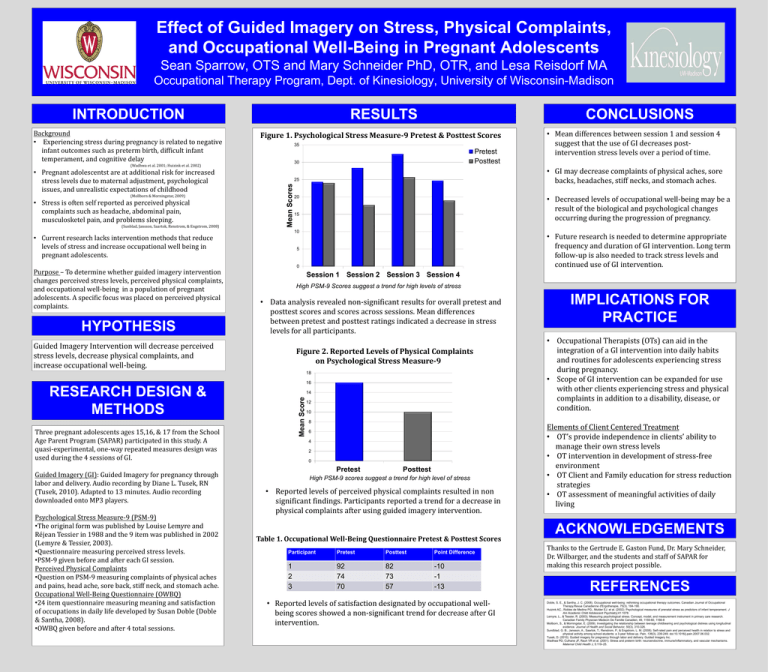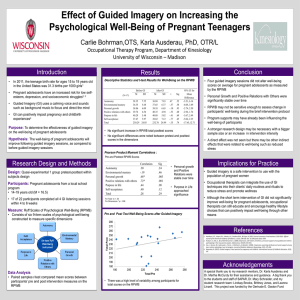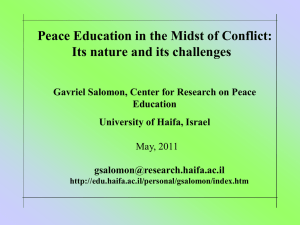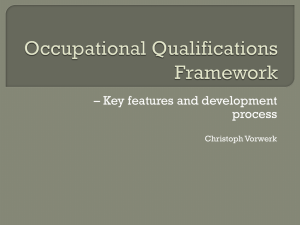Effect of Guided Imagery on Stress, Physical
advertisement

Effect of Guided Imagery on Stress, Physical Complaints, and Occupational Well-Being in Pregnant Adolescents Sean Sparrow, OTS and Mary Schneider PhD, OTR, and Lesa Reisdorf MA Occupational Therapy Program, Dept. of Kinesiology, University of Wisconsin-Madison INTRODUCTION Background • Experiencing stress during pregnancy is related to negative infant outcomes such as preterm birth, difficult infant temperament, and cognitive delay RESULTS Figure 1. Psychological Stress Measure-9 Pretest & Posttest Scores 35 • Stress is often self reported as perceived physical complaints such as headache, abdominal pain, musculosketel pain, and problems sleeping. (Sunblad, Jansson, Saartok, Renstrom, & Engstrom, 2008) Purpose – To determine whether guided imagery intervention changes perceived stress levels, perceived physical complaints, and occupational well-being in a population of pregnant adolescents. A specific focus was placed on perceived physical complaints. HYPOTHESIS • Decreased levels of occupational well-being may be a result of the biological and psychological changes occurring during the progression of pregnancy. 20 15 10 • Current research lacks intervention methods that reduce levels of stress and increase occupational well being in pregnant adolescents. • Future research is needed to determine appropriate frequency and duration of GI intervention. Long term follow-up is also needed to track stress levels and continued use of GI intervention. 5 0 Session 1 Session 2 Session 3 Session 4 High PSM-9 Scores suggest a trend for high levels of stress • Data analysis revealed non-significant results for overall pretest and posttest scores and scores across sessions. Mean differences between pretest and posttest ratings indicated a decrease in stress levels for all participants. Guided Imagery Intervention will decrease perceived stress levels, decrease physical complaints, and increase occupational well-being. Figure 2. Reported Levels of Physical Complaints on Psychological Stress Measure-9 18 16 RESEARCH DESIGN & METHODS Mean Score 14 Three pregnant adolescents ages 15,16, & 17 from the School Age Parent Program (SAPAR) participated in this study. A quasi-experimental, one-way repeated measures design was used during the 4 sessions of GI. Guided Imagery (GI): Guided Imagery for pregnancy through labor and delivery. Audio recording by Diane L. Tusek, RN (Tusek, 2010). Adapted to 13 minutes. Audio recording downloaded onto MP3 players. Psychological Stress Measure-9 (PSM-9) •The original form was published by Louise Lemyre and Réjean Tessier in 1988 and the 9 item was published in 2002 (Lemyre & Tessier, 2003). •Questionnaire measuring perceived stress levels. •PSM-9 given before and after each GI session. Perceived Physical Complaints •Question on PSM-9 measuring complaints of physical aches and pains, head ache, sore back, stiff neck, and stomach ache. Occupational Well-Being Questionnaire (OWBQ) •24 item questionnaire measuring meaning and satisfaction of occupations in daily life developed by Susan Doble (Doble & Santha, 2008). •OWBQ given before and after 4 total sessions. • Mean differences between session 1 and session 4 suggest that the use of GI decreases postintervention stress levels over a period of time. • GI may decrease complaints of physical aches, sore backs, headaches, stiff necks, and stomach aches. 25 Mean Scores (Mollborn & Morningstar, 2009) Pretest Posttest 30 (Wadhwa et al. 2001; Huizink et al. 2002) • Pregnant adolescentst are at additional risk for increased stress levels due to maternal adjustment, psychological issues, and unrealistic expectations of childhood CONCLUSIONS 12 10 8 6 4 2 0 Pretest Posttest High PSM-9 scores suggest a trend for high level of stress • Reported levels of perceived physical complaints resulted in non significant findings. Participants reported a trend for a decrease in physical complaints after using guided imagery intervention. Table 1. Occupational Well-Being Questionnaire Pretest & Posttest Scores Participant Pretest Posttest Point Difference 1 2 3 92 74 70 82 73 57 -10 -1 -13 • Reported levels of satisfaction designated by occupational wellbeing scores showed a non-significant trend for decrease after GI intervention. IMPLICATIONS FOR PRACTICE • Occupational Therapists (OTs) can aid in the integration of a GI intervention into daily habits and routines for adolescents experiencing stress during pregnancy. • Scope of GI intervention can be expanded for use with other clients experiencing stress and physical complaints in addition to a disability, disease, or condition. Elements of Client Centered Treatment • OT’s provide independence in clients’ ability to manage their own stress levels • OT intervention in development of stress-free environment • OT Client and Family education for stress reduction strategies • OT assessment of meaningful activities of daily living ACKNOWLEDGEMENTS Thanks to the Gertrude E. Gaston Fund, Dr. Mary Schneider, Dr. Wilbarger, and the students and staff of SAPAR for making this research project possible. REFERENCES Doble, S. E., & Santha, J. C. (2008). Occupational well-being: rethinking occupational therapy outcomes. Canadian Journal of Occupational Therapy.Revue Canadienne d'Ergotherapie, 75(3), 184-190. Huizink AC., Robles de Medina PG., Mulder EJ. et al. (2002). Psychological measures of prenatal stress as predictors of infant temperament. J Am Academic Child Adolescent Psychiatry;41:1078. Lemyre, L., & Tessier, R. (2003). Measuring psychological stress. Concept, model, and measurement instrument in primary care research. Canadian Family Physician Medecin De Famille Canadien, 49, 1159-60, 1166-8 Mollborn, S., & Morningstar, E. (2009). Investigating the relationship between teenage childbearing and psychological distress using longitudinal evidence. Journal of Health and Social Behavior, 50(3), 310-326. Sundblad, G. B., Jansson, A., Saartok, T., Renstrom, P., & Engstrom, L. M. (2008). Self-rated pain and perceived health in relation to stress and physical activity among school-students: a 3-year follow-up. Pain, 136(3), 239-249. doi:10.1016/j.pain.2007.06.032. Tusek, D. (2010). Guided imagery for pregnancy through labor and delivery. Guided Imagery Inc. Wadhwa PD, Culhane JF, Rauh VR et al. (2001). Stress and preterm birth: neuroendocrine, immune/inflammatory, and vascular mechanisms. Maternal Child Health J, 5:119–25.




